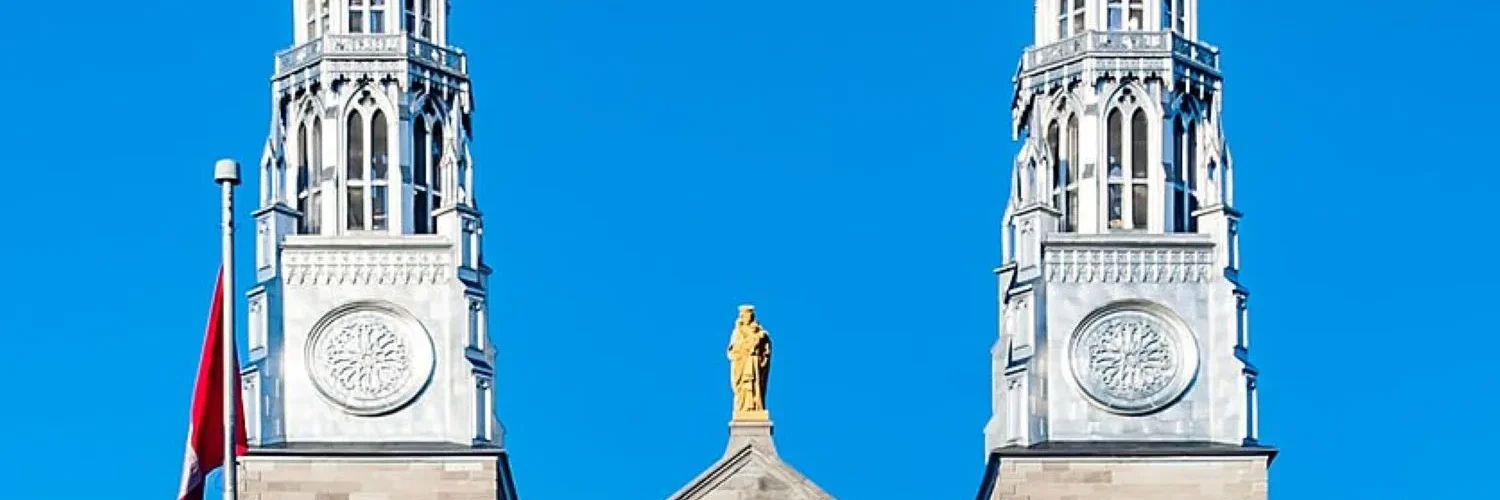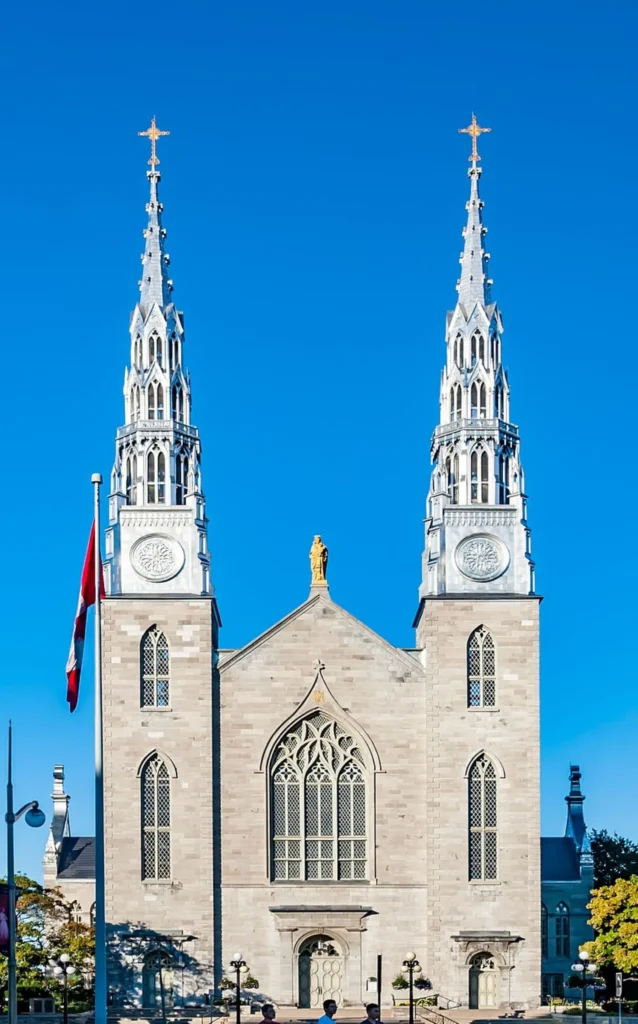
Introduction
The Notre-Dame Cathedral Basilica is a Roman Catholic minor basilica in Ottawa, Ontario, Canada located on 385 Sussex Drive in the Lower Town neighbourhood. It was designated a National Historic Site of Canada in 1990.
The basilica is the oldest and largest church in Ottawa and the seat of the city’s Roman Catholic archbishop. Its twin spires and gilded Madonna are easily identifiable from nearby Parliament Hill and the surrounding area. The church was last renovated and restored in the late 1990s. Services are held in both French and English. Its Easter and Christmas masses are telecast nationally on Salt+Light Television every year.
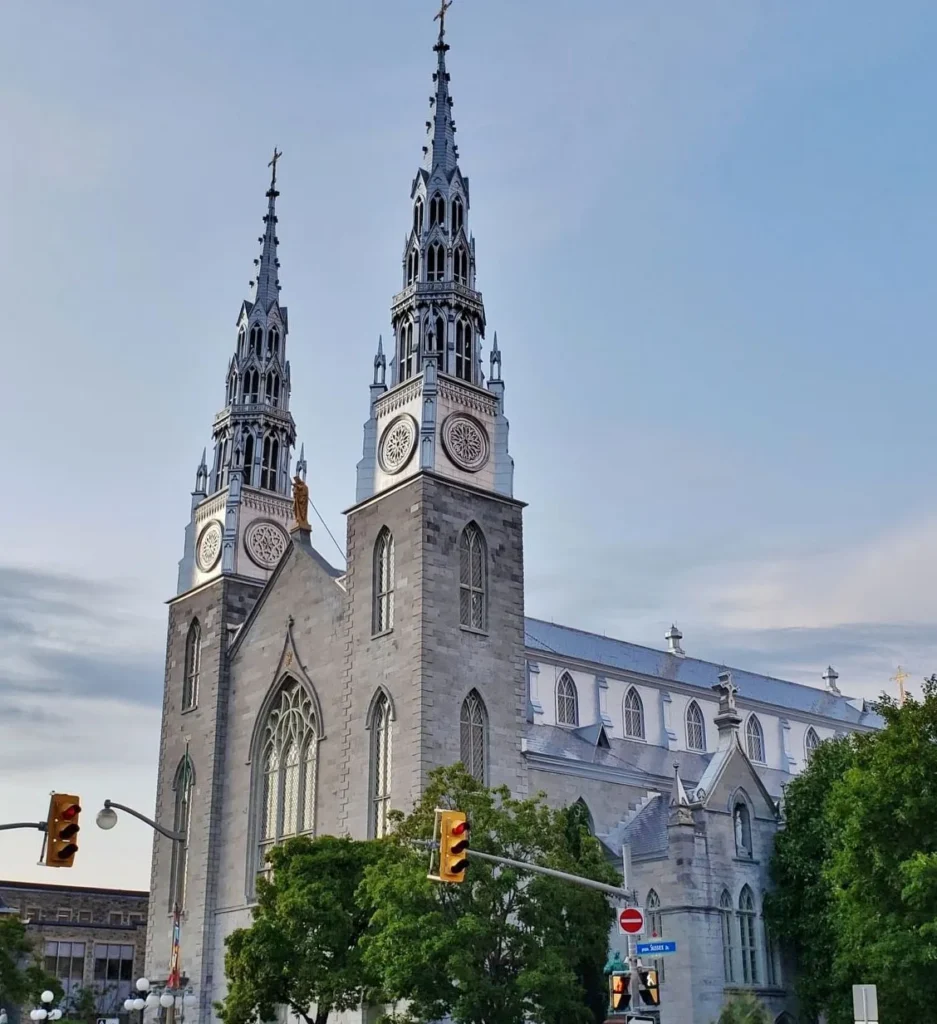
Notre Dame Roman Catholic Basilica National Historic Site of Canada is a large Gothic Revival cathedral, built of ashlar limestone, whose twin towers mark the entrance to Lowertown, one of Ottawa’s earliest neighbourhoods. It is prominently located on Sussex Drive, between St. Patrick and Guigues streets, across from the National Gallery of Canada, in Ottawa’s Lowertown area. As the physical and spiritual centre of Ottawa’s Catholic community, the cathedral is flanked on its south side by the Archbishop’s Palace and on its north side by the former College of Bytown and the Mother House of the Grey Nuns. The formal recognition consists of the cathedral on its legal property at the time of designation.
The site was originally home to the small wooden St. Jacques Church built in 1832. This structure was moved across the street in 1841 to make way for a larger church and two years later was destroyed by a fire. This larger church was designed by local builder Antoine Robillard and Father John Francis Cannon who requested a Neo-classical design. However, in 1844, after the lower section was completed, the Oblate Fathers (OMI) assumed stewardship of the parish and Father Pierre-Adrien Telmon was sent from France to finish the construction. Father Telmon decided to redesign the church into a Neo-Gothic structure, a style which was growing in popularity. This resulted in the lower features, such as the main entrance, being Neo-Classical, while the upper portions of the structure are Neo-Gothic.
The main structure was completed in 1846. In 1847, the church was designated the cathedral of Bytown and Joseph-Bruno Guigues was appointed the first bishop. He is honoured with a lifesize statue at the southwest corner of the cathedral grounds. In 1859, Father Damase Dandurand, OMI, designed the two Gothic spires which were added to the west front in 1866. Earlier, in 1849–50, he designed the Archbishop’s Palace and in 1862–63, added the choir loft. In 1879, Pope Leo XIII designated the cathedral as a minor basilica. James R. Bowes, architect, designed new galleries and other improvements in 1875.
Governor General Georges Vanier and Prime Minister Sir Wilfrid Laurier both were given state funerals at the cathedral. A plaque commemorating the history of the cathedral was later erected near the building. It reads:
“1841-1843 – This Gothic revival structure is the oldest surviving church in Ottawa. Its twin steeples were erected in 1842. In 1848 it was named the Cathedral of the Diocese of Ottawa, then later was granted the title Basilica. Its chief glory is its carved and painted interior. Designated heritage property 1978. “On Dec 18 1999 the most reverend Marcel A Gervais, Archbishop of Ottawa officially reopened Notre Dame Cathedral. The Cathedral had been closed for renovations since the beginning of 1999 and work continued into the year 2000. This historic restoration was made possible through the generous gifts of anonymous donors, the Canada Millenium partnership program, the Ontario Government and the friends of the Cathedral. We also recognize the warm hospitality of the Sisters of Charity of Ottawa who welcomed the community at the Chapel of their Mother House while the Cathedral was closed.”
Architecture of Notre Dame Cathedral, Ottawa, Canada
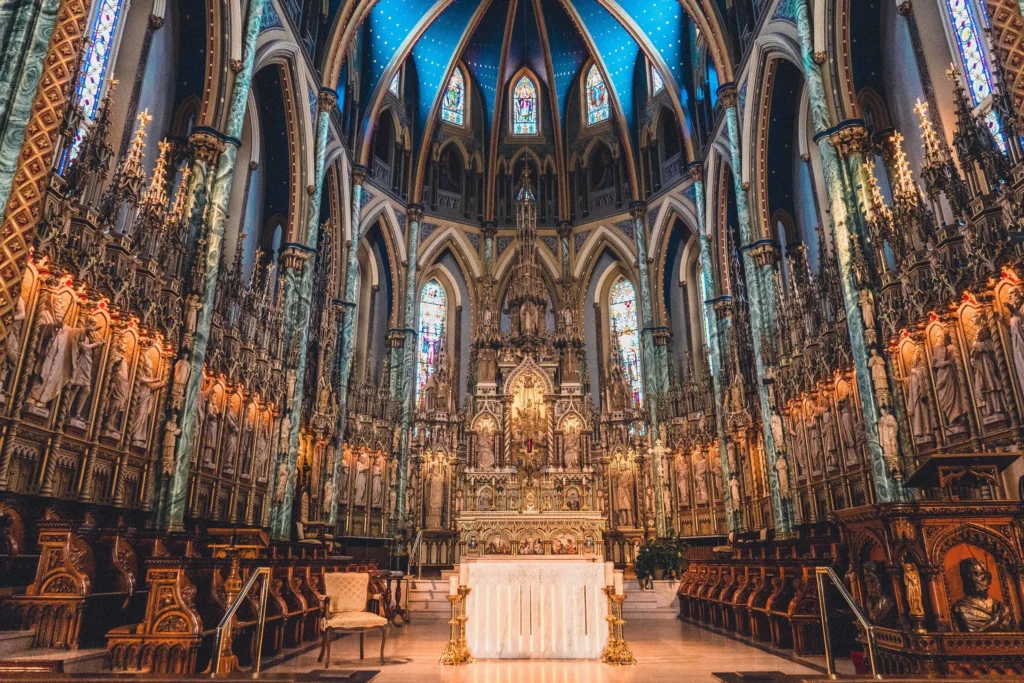
These initiatives were enough to convince the new bishop to give him carte blanche, in 1878, to complete the cathedral’s interior that would be worthy for the National Capital. A new prosperity in the region contributes positively to the diocese’s development. The years of great shortage the Oblates missionnaries experienced are now over. The city of Ottawa, with its new public service, is growing and the Catholic population proportionally increases.
Thanks to this new environment, the construction of the cathedral reaches its peak in the last quarter of the 19th century. To execute the decoration of the sanctuary and the nave, which he has designed himself, Canon Bouillon, between 1878 to 1885, calls on a team of French-Canadian craftsmen and carpenters/sculptors like Flavien Rochon, Philippe Pariseau, Olindo Gratton and Philippe Hébert. They were often the same men who worked on the ornamentation of the Parliament Buildings. Most of them men lived nearby and were either parishioners of the Cathedral or fervent admirers of Bouillon.
Between 1879 and 1887, they created the two lavishly decorated side altars, the main altar with its stunning 16 metre (52 feet) high reredos (pictured), the choir stalls as well as the gallery of some 80 statues in the sanctuary. Renovations and decoration were completed in 1890. The steeples are covered with tin, which is typical for French-Canadian churches, and house a peal of bells. The exterior is fairly reserved, but the interior is far more ornate, designed by Georges Buillon.
The interior of the church is brightly painted and decorated with carved features, exquisite stained glass windows and hundreds of statues of various religious figures. Louis-Philippe Hébert completed thirty large wooden sculptures in the choir. At the end of the choir, the Holy Family is completed with saints John the Baptist and Patrick, the patron saints of French and Irish Catholics.
Organs
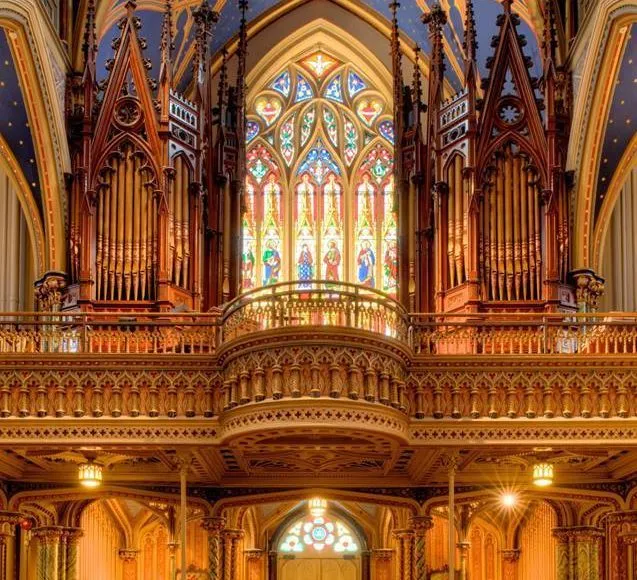
The first organ was inaugurated on March 7, 1850, by Damis Paul, organist at Montreal’s cathedral. The instrument had been partially installed in 1848 for Bishop Guigues’ consecration. Joseph Casavant built an 18-stop instrument (1,063 pipes) and placed it in a case that was later sculpted by Flavien Rochon in 1871. The instrument was restored by organ builder Louis Mitchell a few years later. Casavant’s sons completely reconstructed the organ in 1892. At that time, it was a 52-stop instrument with over 3 manuals and pedal. The instrument used an electro-pneumatic action. The main section of the organ is located in the rear gallery while a second organ, a 17-stop choir organ over 3 manuals and pedal, is located in a gallery over the sanctuary. Both organs are played from the console located in the rear gallery. This instrument is considered[by whom?] one of the three outstanding instruments in the history of the Casavant firm, the others being the one in Notre Dame Basilica in Montreal (1890) and the one in St. Hyacinthe Cathedral (1885).[citation needed]
Originally the console was attached to the left organ case. From the very beginning, the organ case was divided into two sections in order to free the magnificent stained-glass window. New stops were added in 1917. A second console, more modern, was installed in 1940 when a major renovation was undertaken and, in 1975, a revision of the electric action was carried out. In 1999, Guilbault-Thérien carried out a major renovation, replacing the second console, and adding 7 more stops in order to achieve a better balance amongst the divisions while respecting the symphonic aesthetics of the instrument. The chancel organ still retains its original composition and voicing.
Composer Amédée Tremblay notably served as the church’s organist from 1894 to 1920. The present titular organist is Jennifer Loveless.
Feast Day
Notre Dame Cathedral – Ottawa February 2nd
Church Opening Time
Monday to Friday : 9:00 AM – 6:00 PM
Saturday and Sunday : 9:00 AM – 7:00 PM
Mass Timing
Monday – 12:15 PM – (English)
Tuesday – 12:15 PM – (French)
Wednesday – 12:15 PM – (English)
Thursday – 12:15 PM – (French)
Friday- 12:15 PM – (English)
Saturday – 8:30 AM – (French)
Sunday Mass
10:00 AM – (French)
12:00 PM – (English)
5:00 PM – (Bilingual)
Contact Info
Address:
385 Sussex Dr, Ottawa,
ON K1N 1J9, Canada
Phone : +1 613-241-7496
Accommodations
Connectivities
Airway
Ottawa International Airport to Notre Dame Cathedral – Ottawa Distance 22 min (15.9 km) via Route 79 N
Railway
Ottawa Railway Station to Notre Dame Cathedral – Ottawa 10 min (5.9 km) via Vanier Pkwy N/Ottawa Regional Rd 19 and St. Patrick St W/Ottawa Regional Rd 44

